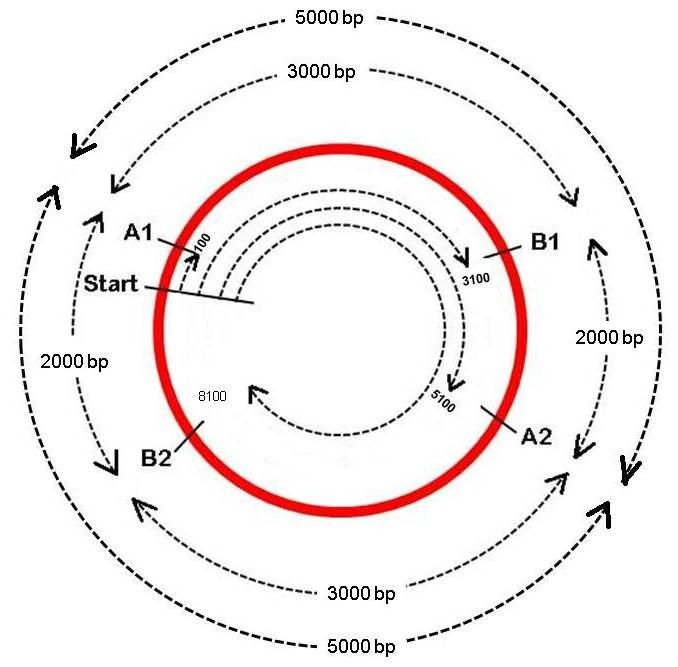
A circular plasmid of 10,000 base pairs (bp) is digested with two restriction enzymes, A and B, to produce a 3000 bp and a 2000 bp bands when visualized on an agarose gel. When digested with one enzyme at a time, only one band is visible at 5000 bp. If the first site for enzyme A (A1) is present at the
A. 3
B. 8
C. 5
D. 8
Answer
507.9k+ views
Hint: Here the length of plasmid is given as 10,000 bp. The lengths of bands refer to the lengths of plasmid DNA fragments after digestion with restriction enzymes. By comparing the total length of plasmid and lengths of plasmid DNA fragments, after digestion with restriction enzymes, first individually and after that double-digestion with both the enzymes at the same time, locations of restriction sites can be measured. This is known as restriction mapping.
Complete Answer:
- When the circular plasmid of 10,000 bp is digested with one enzyme at a time, it gives only one band of 5000 bp. If there is only one site for this enzyme, a single band of 10,000 bp will be produced but the resulting band is of 5000 bp. It means that this plasmid has two restriction sites for this enzyme and these two restriction sites are located 5000 bp far from each other.
- When the plasmid is digested with two restriction enzymes, these 5000 bp fragments (produced by the action of the first enzyme) are further digested by the second enzyme resulting in 2000 bp and 3000 bp fragments. This suggests that this plasmid contains two restriction sites for the second enzyme also.
- The location of first site (A1) for enzyme A is given as
The possible restriction site locations are given in table as below –
In both cases, restriction with two enzymes gives two 2000 bp fragments and two 3000 bp fragments, while restriction with one enzyme at a time gives two 5000 bp fragments (shown in figure).
Among these two possible locations of A2, B1 and B2 one is given in the options, thus, the correct answer is c.

Plasmid (shown in red colour) showing locations of restriction sites for enzymes A & B
Note: Restriction mapping is a method that is used in mapping an unknown segment of DNA. This method involves the use of restriction enzymes. These enzymes can cut or digest DNA molecules at specific sites, and the resultant fragments of DNA are examined by gel electrophoresis technique.
Complete Answer:
- When the circular plasmid of 10,000 bp is digested with one enzyme at a time, it gives only one band of 5000 bp. If there is only one site for this enzyme, a single band of 10,000 bp will be produced but the resulting band is of 5000 bp. It means that this plasmid has two restriction sites for this enzyme and these two restriction sites are located 5000 bp far from each other.
- When the plasmid is digested with two restriction enzymes, these 5000 bp fragments (produced by the action of the first enzyme) are further digested by the second enzyme resulting in 2000 bp and 3000 bp fragments. This suggests that this plasmid contains two restriction sites for the second enzyme also.
- The location of first site (A1) for enzyme A is given as
The possible restriction site locations are given in table as below –
| A1 | A2 | B1 | B2 |
In both cases, restriction with two enzymes gives two 2000 bp fragments and two 3000 bp fragments, while restriction with one enzyme at a time gives two 5000 bp fragments (shown in figure).
Among these two possible locations of A2, B1 and B2 one is given in the options, thus, the correct answer is c.

Plasmid (shown in red colour) showing locations of restriction sites for enzymes A & B
Note: Restriction mapping is a method that is used in mapping an unknown segment of DNA. This method involves the use of restriction enzymes. These enzymes can cut or digest DNA molecules at specific sites, and the resultant fragments of DNA are examined by gel electrophoresis technique.
Latest Vedantu courses for you
Grade 11 Science PCM | CBSE | SCHOOL | English
CBSE (2025-26)
School Full course for CBSE students
₹41,848 per year
Recently Updated Pages
Master Class 11 Business Studies: Engaging Questions & Answers for Success

Master Class 11 Economics: Engaging Questions & Answers for Success

Master Class 11 Accountancy: Engaging Questions & Answers for Success

Master Class 11 Computer Science: Engaging Questions & Answers for Success

Master Class 11 English: Engaging Questions & Answers for Success

Master Class 11 Maths: Engaging Questions & Answers for Success

Trending doubts
1 litre is equivalent to A 1000mL B 100cm3 C 10mL D class 11 physics CBSE

A car travels 100 km at a speed of 60 kmh and returns class 11 physics CBSE

Name the Largest and the Smallest Cell in the Human Body ?

Explain zero factorial class 11 maths CBSE

In tea plantations and hedge making gardeners trim class 11 biology CBSE

What is Environment class 11 chemistry CBSE




